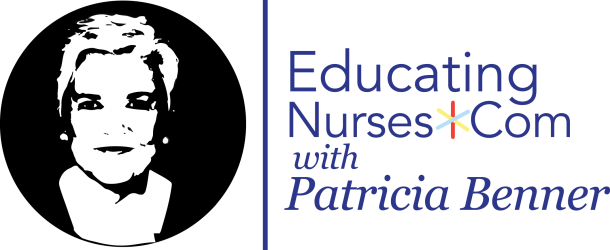By Patricia Benner, copyright 2015
Download PDF
Learning Activities for Teachers and Nursing Students Related to Bringing the Clinical into Classroom Learning:
1. Compose an unfolding case as recommended by Lisa Day in her interview on using unfolding classes. For example, plan the arc of the story. Make sure patient responses actually occurred, and are real. Here is how Lisa Day teaches for a sense of salience in her unfolding cases used in the classroom:
Using Unfolding Case in the midst of teaching pathophysiology, diagnosis, signs and symptoms, and interventions, reasoning through changes in the patient’s condition.
a. What are your concerns about the patient?
b. What is the cause of the concern?
c. What information do you need?
d. What are you going to do about it?
e. What is Ms. G. experiencing?
2. Describe specific teaching strategies that you used in two of your recent classes. With each strategy, please reflect on and answer the following questions. You may choose to check in with students to get a take on their responses to the teaching strategies.
a. To what extent do you think your students could imagine using the knowledge, strategies, in each of your selected teaching strategies?
b. How might you enrich the student’s clinical imagination in each of your selected teaching strategies?
c. Reflect on student engagement and questions during each of the teaching strategies? Were there differences in the level of student-generated questions…in the level of the students’ engagement?
3. Contrast two classroom teaching sessions, for example, Dr. Sarah Shannon, Dr. Patrick Murphy, Dr. Lisa Day or other teachers in this module, and observe and describe these teachers’ strategies for integrating the three Professional Apprenticeships: (Cognitive; Practice; Ethical Comportment and Formation).
a. To what extent do you think each teacher integrated knowing-that and knowing-about, as well as knowing-how and knowing-when?
b. What strategies did the teacher use to engage their students in imagining relevant clinical situations?
4. Examine the organization and orchestration of Dr. Glenise McKenzie’s flipped classroom . View her interview, and reflect on her planning for the classroom.
a. What strategies used by Dr. McKenzie contribute to deep learning?
b. Contrast the flipped classroom approach with a more traditional power point lecture naming the plusses and minuses for each strategy.
c. What were the strategies that Dr. McKenzie used to create clinical imagination?
d. Describe at least three examples in the classroom of the students using knowledge.
